When choosing a motorcycle, understanding engine displacement, evaluating its impact on performance, and recognizing how it shapes your riding experience are essential. You might think that bigger is always better, but that's not necessarily true. The right engine size can enhance your control and enjoyment on the road, whether you're cruising down the highway or maneuvering through city streets. What factors should you consider when determining which displacement suits your needs best?
Key Takeaways
- Engine displacement directly influences power output, affecting acceleration and overall performance of the motorcycle.
- Larger displacements provide enhanced torque and horsepower, making them ideal for highway cruising and long rides.
- Smaller engines offer better fuel efficiency and nimble handling, suited for urban riding and tight corners.
- Understanding displacement helps riders choose motorcycles that align with their riding style and experience level.
Understanding Engine Displacement
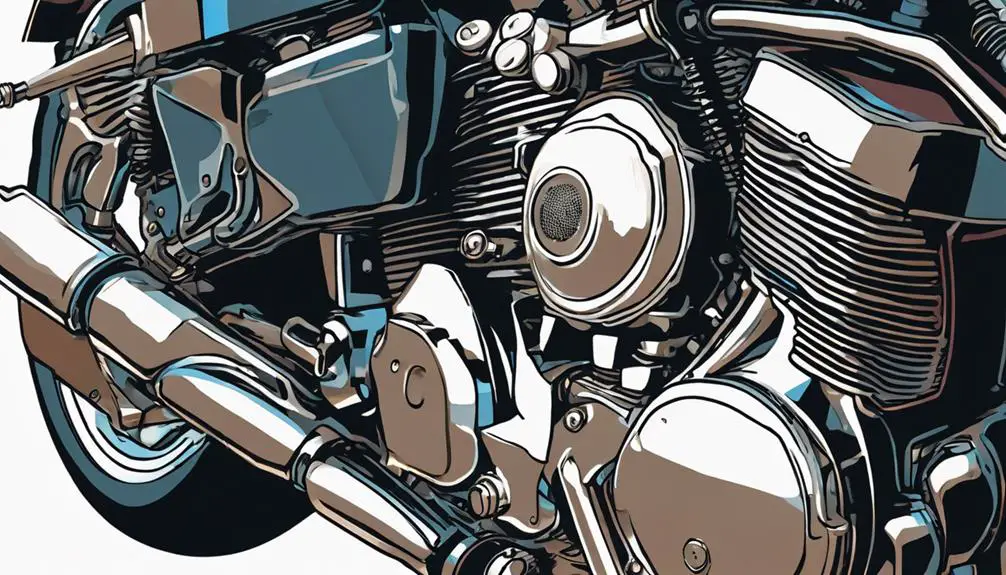
Engine displacement refers to the total volume of all the cylinders in a motorcycle's engine, and it plays an essential role in determining the bike's power and performance. When you think about displacement, imagine how much air and fuel can be pushed through those cylinders. The larger the displacement, the more air and fuel your engine can burn, which often translates to greater power.
For those seeking freedom on two wheels, understanding engine displacement is vital. It affects not just how fast you can go, but how your motorcycle feels as you ride. A bike with a larger displacement can offer a more exhilarating experience, delivering power on demand. You'll notice the difference when you twist the throttle and feel that surge of energy propelling you forward.
Conversely, smaller displacement engines can provide nimble handling and better fuel efficiency, perfect for urban riding or longer journeys. Ultimately, knowing the intricacies of engine displacement empowers you to choose a motorcycle that aligns with your desire for liberation and adventure.
Importance in Motorcycle Performance
Understanding the importance of engine displacement can greatly enhance your motorcycle's overall performance and riding experience. Engine displacement directly influences how much power your bike can generate. A larger displacement often means more torque and horsepower, giving you that exhilarating pull you crave when you twist the throttle.
When you choose a motorcycle with the right displacement for your needs, you're not just picking a number; you're embracing the freedom to ride in a way that suits your style. Whether you're cruising through city streets or tearing down open highways, the right engine size can provide better acceleration and smoother rides.
Smaller engines may offer agility and efficiency, perfect for urban riding, while larger engines can deliver the raw power and stability needed for long-distance journeys. It's about finding the balance that resonates with your spirit of adventure.
Consider how displacement affects handling, fuel efficiency, and maintenance, too. Understanding these factors allows you to make an informed choice, leading to a more liberating experience on the road. By aligning your motorcycle's engine displacement with your riding goals, you reveal the true potential of your journey.
Ducati's Engine Displacement Options
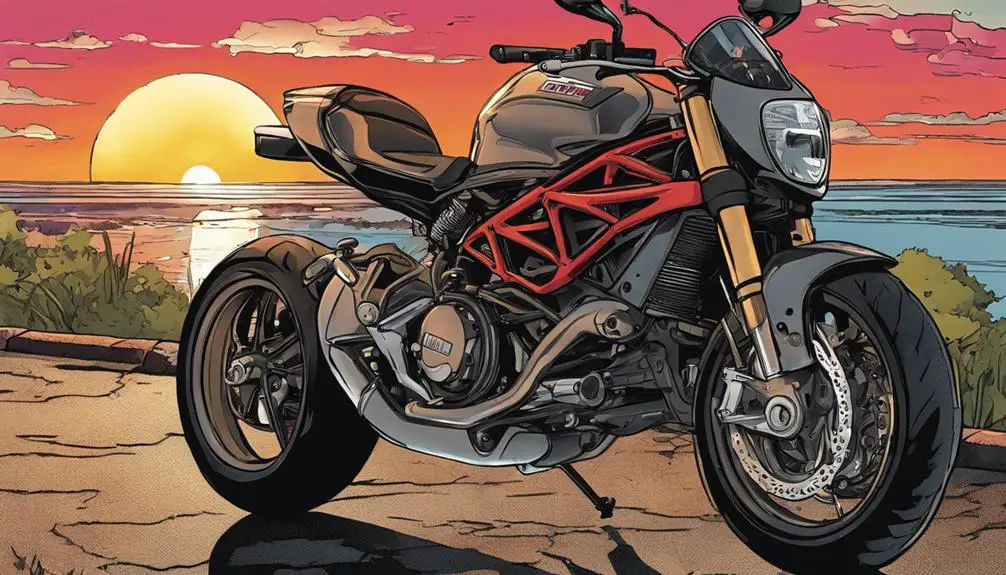
Ducati offers a range of engine displacement options that cater to different riding styles and preferences, ensuring you find the perfect match for your adventures. Whether you crave the raw power of a larger engine or the nimble agility of a smaller one, Ducati's lineup has something for everyone.
If you're looking for thrilling speed, models like the Panigale V4 with its 1103cc engine can release your inner racer. On the other hand, the Monster series provides lighter options, ranging from around 797cc to 1200cc, giving you the freedom to navigate city streets or twisty roads with confidence.
For those who prefer a more laid-back cruising experience, the Multistrada series offers a versatile range of displacements, allowing you to tackle long journeys or weekend getaways effortlessly. With options like the 950cc and 1260cc engines, you can tailor your ride to match your desires.
Ultimately, Ducati empowers you to choose an engine that resonates with your spirit of adventure, enhancing your riding experience and liberating your passion for the open road. Embrace the thrill—your perfect Ducati awaits!
Historical Context of Ducati Engines
When you look at Ducati's history, you'll see a rich tapestry of early innovations that set the stage for their legendary engines.
Understanding the timeline of their engine evolution reveals how performance and racing have shaped their design philosophy.
Let's explore how these elements have influenced Ducati's reputation in the motorcycle world.
Early Ducati Innovations
In the early days of motorcycle engineering, innovative designs from Ducati set the stage for advancements in engine displacement that would shape the industry. You might find it fascinating how Ducati embraced creativity and pushed boundaries. Their introduction of the L-twin engine in the 1950s not only offered more torque but also a significant power boost. This design became a hallmark of their engineering philosophy, focusing on performance and efficiency.
Ducati's use of desmodromic valve systems further exemplified their commitment to innovation. By utilizing this unique mechanism, they guaranteed ideal valve control, maximizing power delivery and enhancing reliability. You can appreciate how these early innovations weren't just technical achievements; they represented a shift towards liberation in motorcycle performance.
These pioneering efforts set Ducati apart, allowing riders to experience the thrill of freedom on two wheels like never before. The synergy of design and function in their early engines became a symbol of the adventurous spirit that defines motorcycling. Embracing these innovations, you join a legacy that celebrates the quest for speed and the joy of the ride.
Engine Evolution Timeline
The evolution of engine technology in Ducati motorcycles reflects a rich history of innovation and engineering excellence that has continually pushed the boundaries of performance.
From the early 1950s, when Ducati first introduced its 175cc engine, you can trace a lineage of advancements that signify the brand's commitment to power and agility. With each decade, Ducati has embraced new technologies and materials, refining its designs to deliver thrilling riding experiences.
In the 1970s, the introduction of the iconic L-twin engine marked a pivotal moment, offering a unique balance of torque and horsepower that set Ducati apart from competitors.
Fast forward to the 1990s, when the Desmodromic valve system revolutionized engine performance, allowing for higher RPMs and improved efficiency.
As you explore Ducati's history, you'll notice how each engine iteration has been a response to riders' desires for speed and control.
The modern era showcases advanced electronics and fuel injection systems, enhancing both power delivery and rider engagement.
Embracing this evolution, Ducati continues to inspire a sense of freedom, proving that every ride is a demonstration of their relentless pursuit of engineering excellence.
Performance and Racing Impact
Ducati engines have consistently delivered exceptional performance that hasn't only shaped the brand's identity but also left a lasting impact on the world of motorcycle racing. When you throw a leg over a Ducati, you tap into decades of engineering excellence and racing heritage. From the iconic L-twin engines to the revolutionary Desmodromic valve system, every innovation pushes the boundaries of what's possible on two wheels.
In racing, Ducati's success isn't just about power; it's about balance, handling, and responsiveness. These machines have dominated tracks like Mugello and Laguna Seca, proving that engine displacement is just one piece of the puzzle. The way a Ducati engine delivers torque gives you that exhilarating feeling of liberation, allowing you to carve through corners with confidence.
Ducati's commitment to performance means you're not just riding a motorcycle; you're participating in a legacy. Each race win echoes the spirit of freedom and passion, urging you to experience the thrill of speed and precision. So, when you consider engine displacement, remember it's about more than numbers; it's about the emotions and experiences that come with every twist of the throttle.
Comparing Displacement Across Models
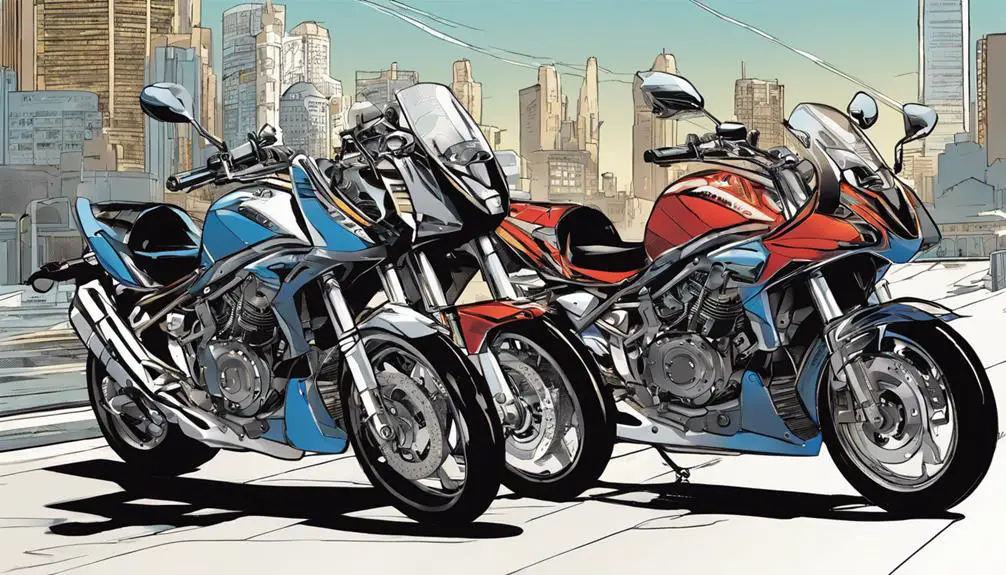
Motorcycle enthusiasts often find themselves intrigued by how displacement varies across different models, influencing performance and riding experience.
When you explore various motorcycles, you'll notice that smaller displacements often offer nimble handling and ease of control, making them perfect for city riding and beginners. On the other hand, larger displacements deliver raw power and torque, ideal for highway cruising and aggressive acceleration.
As you compare models, consider how displacement aligns with your riding style. A 250cc bike may feel liberating for urban commutes, while a 1000cc beast can offer the thrill of open roads. You might also encounter mid-range options, such as 500cc or 750cc, which strike a balance between power and agility, allowing for versatility in various riding conditions.
Don't forget to take into account the engine configuration—like single-cylinder, parallel-twin, or V-twin—since these factors can further influence your experience.
Impact on Handling and Weight
Understanding how engine displacement impacts handling and weight can greatly enhance your riding experience and overall performance on the road.
Larger displacement engines typically add weight, which can affect how your motorcycle feels during turns and at higher speeds. If you crave agility and responsiveness, you might prefer a bike with a smaller engine. These lighter machines allow for quicker flicks and more precise maneuvers, giving you that exhilarating sense of freedom as you navigate through traffic or twisty roads.
On the flip side, a larger engine often provides more torque, which can be beneficial for stability, especially on the highway. You'll feel that power when you need to overtake or climb steep hills. However, you might sacrifice some nimbleness in tight corners.
Ultimately, it's about finding the right balance that suits your riding style. Think about where you'll be riding most often and how you want your bike to respond.
When you align engine displacement with your handling preferences, you reveal a new level of liberation on two wheels. Choose wisely, and let your motorcycle become an extension of your spirit.
Common Problems With Displacement
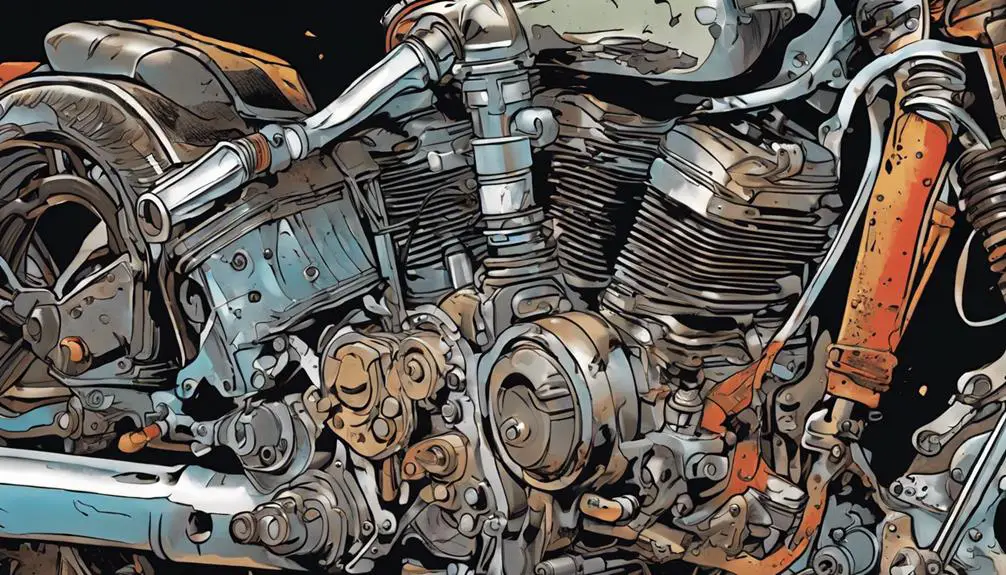
Engine displacement can lead to a variety of common problems that every rider should be aware of to maintain ideal performance and safety. One major issue is engine overheating, particularly in high-displacement bikes. If your engine's too big for the bike's design, it might struggle to dissipate heat effectively, which can lead to mechanical failure.
You might also experience fuel inefficiency. Larger engines often consume more gas, but if your bike's not tuned properly, you could be wasting fuel without gaining the power you crave.
Don't overlook the impact on handling. Bikes with excessive displacement can feel unwieldy, making it harder to navigate tight corners or respond quickly to obstacles. This can compromise your riding experience and put you at risk.
Choosing the Right Displacement
When choosing the right engine displacement for your motorcycle, it's essential to understand how engine size affects power and performance.
Your riding style also plays a significant role in this decision, as different displacements suit various needs.
Let's explore these key points to help you make an informed choice.
Understanding Engine Size
How do you determine the right engine displacement for your riding style and needs?
First, think about how you want to ride. If freedom on the open road calls to you, a larger displacement might suit your adventurous spirit. Bigger engines typically offer more torque, allowing you to conquer hills and highways with ease.
However, if you prefer zipping through city streets or maneuvering tight corners, a smaller engine could provide the agility and responsiveness you crave.
Next, consider your experience level. If you're just starting out, a smaller bike with a lower displacement can help you build confidence without overwhelming you.
On the other hand, seasoned riders might feel the need for more power, pushing them toward larger engines that deliver exhilarating performance.
Power and Performance Balance
Finding the right balance between power and performance means considering not just engine size, but also how it fits your unique riding style and preferences.
When you're choosing displacement, think about what kind of experience you seek on the open road. A larger engine often delivers more horsepower and torque, giving you that exhilarating rush you crave. However, with great power comes the need for greater control.
If you're after speed and acceleration, a high-displacement engine could be your ticket to freedom. But remember, that power can also lead to a heavier bike, which mightn't suit all riders.
On the other hand, smaller engines can offer nimbleness and agility, perfect for carving through city streets or winding roads.
Ultimately, it's about harmonizing that raw power with your ability to handle it. You want a ride that feels like an extension of yourself, not a burden.
Riding Style Considerations
Your riding style plays an essential role in determining the right engine displacement for your motorcycle. If you crave adventure and long-distance journeys, a larger displacement engine might be your best bet. It delivers the power and torque needed to tackle highways and steep inclines with ease.
On the other hand, if you enjoy weaving through city traffic or prefer a more laid-back ride, a smaller displacement bike could offer the nimbleness and agility you desire.
Consider how you intend to use your motorcycle. Are you chasing thrills on the open road, or do you seek freedom in urban exploration? A powerful engine can provide exhilarating acceleration, but it mightn't be necessary for casual cruising.
Don't forget about your comfort level with handling different sizes. A lighter bike with smaller displacement can be easier to maneuver, especially for new riders or those who value a more spirited, responsive ride.
Ultimately, it's about finding the balance that resonates with your sense of freedom. Choose wisely, and let your motorcycle reflect your unique riding spirit.
Future Trends in Engine Displacement
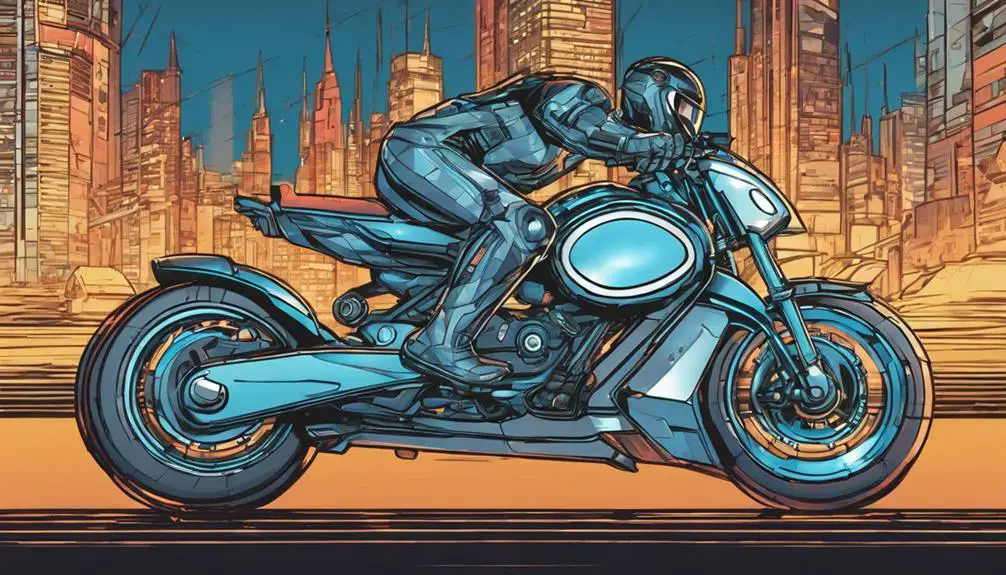
As motorcycle manufacturers innovate, you'll likely see a shift towards smaller, more efficient engine displacements that prioritize performance and fuel economy. This movement isn't just about numbers; it's about liberation on two wheels. You'll find bikes that pack a punch while being lighter and easier to handle, enhancing your overall riding experience.
With advancements in technology, expect to see engines that maximize power output without sacrificing torque. This means you can enjoy thrilling rides without the guilt of excessive fuel consumption. Plus, as eco-consciousness grows, smaller engines align with sustainable practices, allowing you to connect with nature rather than harm it.
Electric motorcycles are also entering the scene, showcasing how engine displacement can evolve beyond traditional boundaries. They offer you a silent, smooth ride that redefines freedom. As more manufacturers invest in electric technology, you'll find that performance won't be compromised.
In the coming years, you'll embrace the fusion of performance, efficiency, and sustainability. Smaller, smarter engines will empower you to ride further, faster, and cleaner, giving you the freedom to explore your world while respecting it. Get ready for a thrilling ride into the future!
Frequently Asked Questions
How Does Engine Displacement Affect Motorcycle Insurance Rates?
Engine displacement directly impacts your motorcycle insurance rates.
Generally, larger engines mean higher performance, which can lead to increased risk in the eyes of insurers. If you've got a bike with a bigger displacement, you might face higher premiums.
On the flip side, smaller engines often result in lower rates due to perceived safety.
Can Engine Displacement Impact Fuel Efficiency?
Imagine your bike's engine as a vast ocean; its displacement determines how much fuel it can draw from those waters.
Yes, engine displacement can impact fuel efficiency. Generally, smaller engines consume less fuel, offering better mileage, while larger engines often use more fuel for the power they deliver.
What Is the Relationship Between Displacement and Emissions Regulations?
When you think about engine displacement and emissions regulations, you realize they're closely linked.
Larger engines often produce more emissions, which means stricter regulations kick in. Manufacturers must balance power with compliance, leading to innovations in technology.
You might see smaller engines being optimized to meet standards while still delivering performance.
How Does Engine Displacement Relate to Motorcycle Licensing Requirements?
Think of engine displacement as the key to freedom on two wheels. It directly influences motorcycle licensing requirements, with many regions setting limits based on engine size.
If you're eyeing a bigger bike, you'll often need a higher-class license. These regulations guarantee you've got the skills to handle more power.
Are There Specific Maintenance Considerations for Different Engine Displacements?
When you own a motorcycle, maintenance needs can vary with engine displacement.
Smaller engines often require less frequent oil changes and simpler upkeep, while larger engines might demand more attention and higher-quality parts.
You'll need to take into account factors like cooling systems, fuel types, and even tire pressure.
Staying informed about your bike's specific requirements empowers you to keep it running smoothly, ensuring your ride is as liberating as it should be.
Conclusion
In the end, choosing the right engine displacement is like picking the perfect surfboard for a wave; it's all about matching your skill and style to the conditions.
A larger engine may feel like riding a powerful swell, while a smaller one lets you dance through tight curls with ease.
Understanding your needs and preferences guarantees you'll hit the road with confidence, enjoying every twist and turn, just as a surfer savors the rush of the ocean.